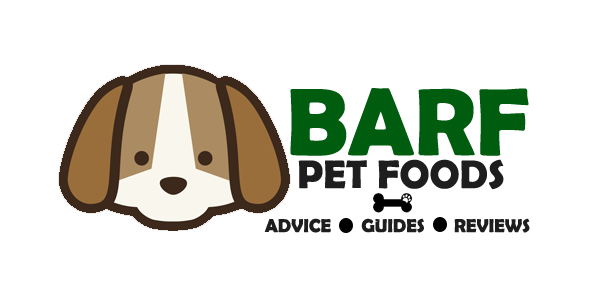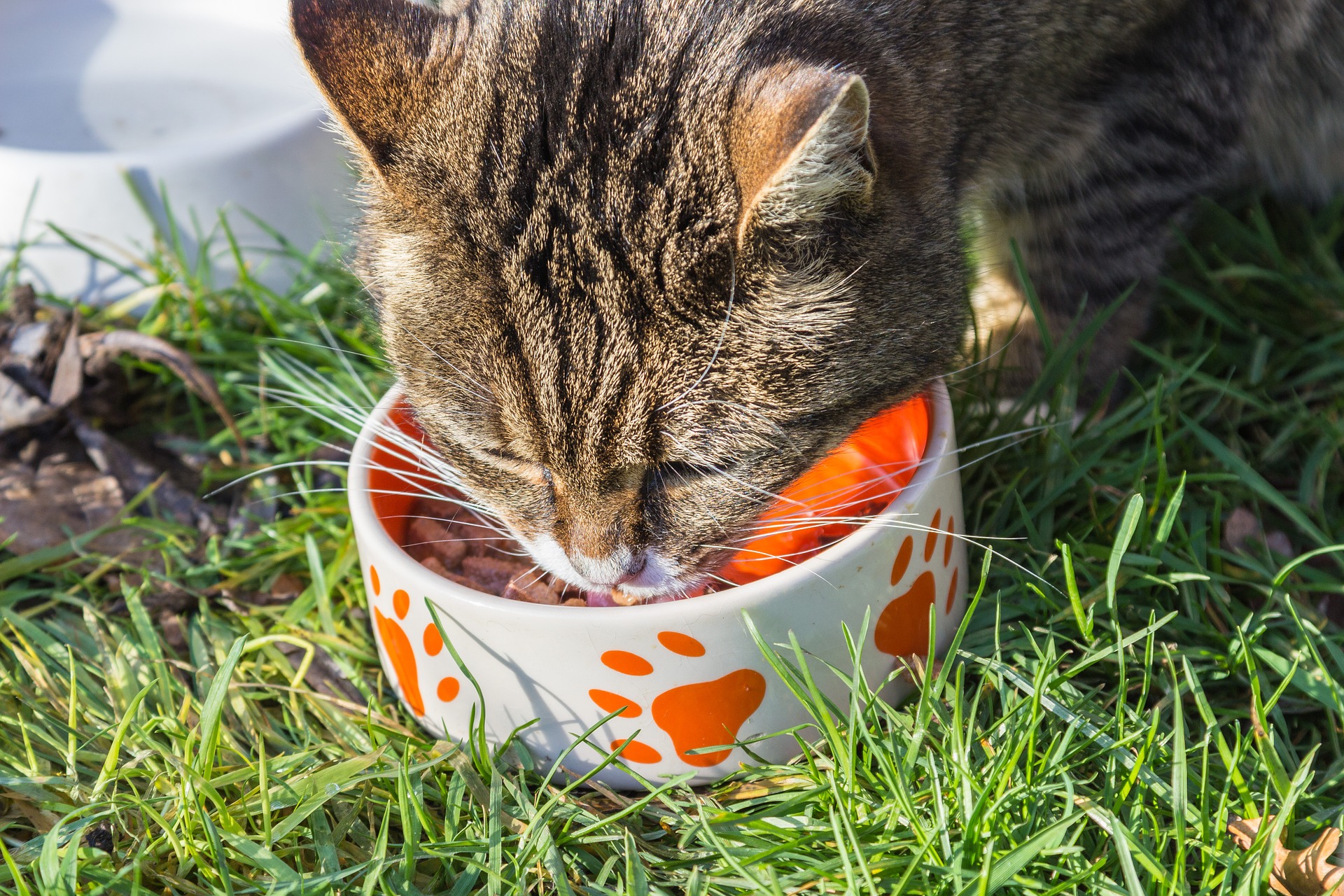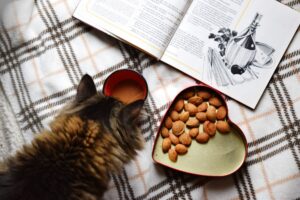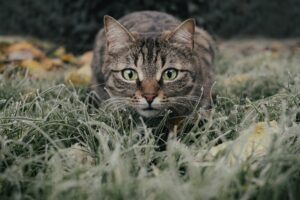There are no two ways about it; the ‘right’ diet is critical for your cat’s health, vitality, and wellbeing. But what actually is the ‘right’ diet, and what cat foods are the most nutritious?
Well, in today’s article, we’re going to explore this topic and look at what you should be feeding your cat, the changes that must be made to your cat’s diet as they grow, and how to ensure they’re getting the most nutritious diet possible throughout their lives. So, without further ado, let’s begin.
Nutritious Cat Foods: An Introduction
Sadly, animal obesity is an ever-growing problem here in the UK. Every year, vets see thousands of pets that are overweight, often resulting in a wide array of serious health conditions which reduce quality of life and reduce longevity.
Although overall health and activity levels play a role in weight management, the key piece of this jigsaw is, of course, diet. But how can you ensure that your cat is getting the most nutritious food throughout its life?
Let’s take a look.
Nutritious Cat Foods: The Complete Guide
Cats are ‘obligate carnivores’, which means they are a class of animal that strictly eats meat.
Cats require specific nutrients from animal-based protein sources that their bodies are unable to synthesise. For example, the amino acids Arginine and Taurine; these two essential amino acids are vital for your cat’s health, and without them, your feline friend would suffer, potentially becoming seriously ill.
The quickest and easiest way to avoid health is by feeding your cat a ‘complete’ food, i.e. one that contains everything your cat needs to stay healthy, happy, and active. Of course, the food you give your cat will need to change depending on how old they are, as kittens have different nutritional requirements to adults cats who have different requirements to senior cats.
Here is a list of the life-stages of a cat for your reference:
Kitten: between 0-12 months.
Adult: between one and seven years.
Senior: between seven and eleven years.
Geriatric: over the age of eleven.
Let’s look at how feeding should vary throughout the life stages of your cat.
The Most Nutritious Food For Kittens
From around the three-week mark, kittens should begin to eat solid foods. When feeding very small kittens, always opt for soft foods that are very easy to digest, such as dry food soaked in kitten milk or water (don’t use cow’s milk, it can play havoc with their stomach and digestive system). Food should be given in small amounts as your kitten will still be feeding from their mother.
Once your kitten reaches around eight weeks old, their meal frequency should be reduced and continue to be reduced until they reach six months, at which point they’ll be down to around three smaller meals per day.
Due to a kitten’s naturally high energy (and energy output) levels, they will typically require high amounts of protein (between 30-40%), amino acids, minerals, and vitamins. Therefore, finding food specifically formulated for kittens is a must.
If your kitten has come from an animal shelter, ask what they have been fed on as an abrupt change in their diet may lead to an upset stomach and digestive issues, something that all parties will be glad to avoid!
The Most Nutritious Food For Adult Cats
Adults cats often have a preference to graze on their food, so providing several smaller meals over the course of the day is often the best way forward (as it mimics their natural feeding habits). Weighing your cat on a regular basis will help you to keep tabs on their weight and whether or not you need to increase or decrease their food portions. Of course, if your schedule doesn’t allow for you to feed your cat more than once or twice per day, that’s absolutely fine; provided they get their macronutrient, and micronutrient requirement met, it shouldn’t make too much difference.
As a general rule, adult cats need somewhere between 35-40% protein in their diet. Wet food will typically have higher levels of protein than dry food, but the source of protein is equally – if not more – important. Always aim to feed your cat protein from animal sources, i.e. meat. Sadly, many cheap cat foods contain lots of cereals and grains, which, although are high in protein, are not the best protein sources for felines.
How do you know if your cat is eating enough protein? If their coat is shiny, they appear healthy, have plenty of energy, and seem their normal selves; it’s highly likely that they’re getting sufficient protein. Healthy adult cats can handle excessive amounts of protein (which will be excreted or converted into fat), so don’t be afraid of feeding them a little more protein; it’s better to feed a little more than not enough. High-protein diets can help cats to stay healthy and lean; however, high-protein doesn’t always mean low-calorie, so it’s imperative to keep a firm grip on how much food you’re feeding your feline friend; otherwise, they may end up overweight.
The Most Nutritious Food For Senior Cats
Getting a kitten’s or adult cat’s diet ‘right’ isn’t all that difficult; however, the same can’t be said for senior cats. Unfortunately, senior cats, i.e. those aged seven years and above, are at a much higher risk of developing CKD (Chronic Kidney Disease). Consuming high amounts of protein can exacerbate kidney damage in senior cats with CKD; therefore, it’s crucial to ensure your senior cat consumes slightly less protein than it did during its adult life-stage. However, it’s imperative not to reduce protein by too much as this can lead to a decrease in muscle mass, which will make them less mobile and reduce energy levels. Furthermore, ensuring that your cat is hydrated at all times will help their kidney’s to function optimally, so have plenty of clean, fresh water available in and around your house (not near their food, though). Adding water to both wet and dry foods can also help to boost their water intake.
Of course, not all senior cats will suffer from CKD, so having regular check-ups at the vet is vital to assess your senior cat’s current health. If they’re free from CKD or any other kidney-related ailments, feeding them a high-protein diet (30-40%) shouldn’t pose much (additional) risk; however, it’s always best to focus on protein quality rather than protein quality when your cat reaches their senior years. For example, when looking at cat food labels, if the first ingredient is a meat source, you can assume it’s a high-quality protein and, therefore, most likely a nutritious and good choice of food.
Senior cats are also prone to dental issues, which may reduce their ability and/or desire to eat. If you notice any changes to their appetite, consult your vet straight away.
The Most Nutritious Treats For Cats
Cats don’t need treats, but we, as humans, love to give our pets treats from time to time, so when you do, it’s best to give them as nutritious treats as you can source. The ideal cat treat will come in the form of 100% natural, pure, unadulterated meat such as tuna flakes (in spring water) or chicken.
However, there is a wide range of healthy treats currently available on the market, so certainly don’t discount these. Avoid those that are primarily cereal- or grain-based and instead look for those that are made entirely (or nearly entirely) from meat, with as few added ingredients as possible.
Help Your Cat Live Longer With These Expert Diet Tips
#1 – Canned Over Kibble
As already mentioned, cats are carnivorous; therefore, the vast majority of their diet must come from meat. Although there is a selection of high-quality kibble/dry foods available on the market, most do not meet the protein requirements needed by felines. Plus, they are – by their very nature – dry and often contain too many carbohydrates. While it is not impossible to find a kibble cat food that meets your cat’s dietary needs, it’s much easier finding canned cat food that does this job (and does it well).
#2 – Be Vigilant When Making Homemade Cat Foods
If you’ve decided to make your own cat food at home, always speak to your vet prior to doing so. Shop-bought foods are formulated to contain a wide array of essential micronutrients that are vital for your cat’s health and vitality; therefore, it’s unlikely you’ll be able to replicate this from homemade food. Your vet will advise you in which supplements, minerals, vitamins etc., you’ll need to ensure your homemade cat food is a ‘complete’ food.
#3 – Does Your Cat Have Specific Needs?
Always tailor your cat’s diet to fit their specific needs. Broadly speaking, all cats have the same requirements, but, just like humans, health conditions can alter dietary requirements. If your cat has regular check-ups at the vet and all is well, you can feed them regular, high-quality, shop-bought food; however, if they have a specific ailment or condition, a specialise food may be necessary.
#4 – Avoid Potentially Harmful Foods and Ingredients
It’s completely natural to want to give your cat treats, but with so many foods toxic to cats giving them something that is potentially harmful is easily done. While there are a wide array of foods that should you avoid feeding your cat, here are the ones you should avoid at all costs: onion, garlic, caffeine, dairy, chives, chocolate, yeast, and grapes. Although small amounts of these foods may not have any long-lasting effects, they have the potential to be lethal, so avoid them.
#5 – Frequency and Volume of Feeding
In the wild, cats hunt several times per day; therefore, it’s important to mimic this where their feeding is concerned. The key to doing this is to feed them small meals several times throughout the day. Of course, the volume of food you give them will depend on their age, weight, activity level, and health, but it’s important to feed little and often.
#6 – The Perfect Weight
As the incase with all animals, avoiding being underweight or overweight is key to improving and prolonging life. Obesity is a gateway to a myriad of serious health complications, such as heart disease, cancer, diabetes, joint issues, and much, much more; therefore, ensuring your cat is eating just enough to maintain its current weight is essential. Avoid overeating by not leaving out once your cat has finished eating. Do not allow your cat to graze when and where they like as, just like humans, snacking can quickly lead to piling on the pounds.
#7 – Trying a New Food? Introduce it Gradually
If you’re considering changing your cat’s food or diet, always transition gradually. Making sweeping changes and abruptly introducing them to your cat may cause stomach and digestion issues, which is, of course, something you want to avoid. Furthermore, it’s always wise to speak to your vet before making any changes to your cat’s diet to garner their opinion and thoughts.
# 8 – Hydration
In the wild, cats will get most of their water through the animals they hunt, so their inclination to drink is almost non-existent. However, as your cat is likely not wholly wild (or wild at all) means that easy access to water is essential; otherwise, they may be in a permanent state of dehydration, which is fatal. As cats prefer moving water sources, a water fountain will typically help to encourage them to drink. Although canned food will also provide some hydration, you must ensure there are plenty of water sources in and around your home.






